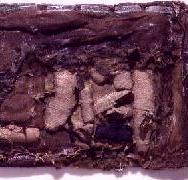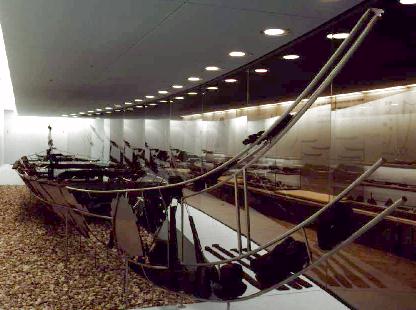CONSERVATION OF WATERLOGGED WOOD - PART 2
The introduction of Polyethylene glycol as an impregnant for waterlogged
wood
Many new synthetic materials came into use after the Second World War.
One of these is polyethylene glycol (PEG), which is a water soluble, waxy
material. It can be obtained in different molecular sizes. The small molecules,
described as PEG 200 - PEG 400, are liquid and penetrate furthest into
the wood. The larger molecules, PEG 1500 to PEG 4000, are solid. Their
penetrating power is less but they are better at stabilizing the wood.
Re-conservation of the Hjortspring boat
The Hjortspring finds were re-conserved between 1966 and 1979, by replacing
the alum with PEG.

First the pieces were wrapped in muslin and packed in mineral wool
in wooden boxes (see illustration). Wax and lacquer were removed in an
acetone bath. The alum and glycerol were then washed out with water, a
process that took about a year. The wood fragments were then re-impregnated
with PEG.

In 1989 the Hjortspring boat could again be seen in the National
Museum.
Conservation of the Viking ships
PEG 4000 was used in the 1960's for the preservation of the Viking ships
that were found in Roskilde Fjord. All the water in the ships' timber was
slowly replaced by PEG during a long period of impregnation in large tanks.
This method is still used for large pieces of wood that are only slightly
decomposed. Objects conserved in this way are very dark and heavy.

The boats in the Viking Ship Museum in Roskilde, conserved with
PEG
The next section: freeze drying


